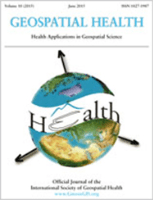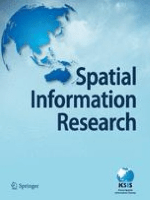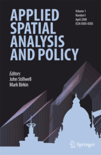
Geospatial Health
Scope & Guideline
Unveiling Spatial Insights for Health Innovation.
Introduction
Aims and Scopes
- Geospatial Epidemiology:
The journal emphasizes the use of geospatial techniques to study the distribution and determinants of health-related states or events in specified populations, often employing spatial statistics and GIS tools. - Public Health Interventions:
Research often includes evaluations of public health interventions utilizing geospatial methods to identify high-risk areas and populations, aiming to improve health outcomes through targeted strategies. - Environmental Health Analysis:
The journal investigates the relationship between environmental factors and health outcomes, focusing on how geographical and climatic variations influence disease patterns and public health. - Health Accessibility and Equity:
A core area includes studies on spatial accessibility to healthcare services, exploring disparities in health service availability and how socio-economic factors influence access. - Methodological Innovations:
Geospatial Health encourages the development and application of new methodologies in spatial analysis, including machine learning, Bayesian models, and interactive mapping technologies for enhanced data visualization and interpretation.
Trending and Emerging
- Impact of Climate Change on Health:
There is a growing emphasis on studying how climate change affects disease incidence and health risks, reflecting global concerns about environmental impacts on public health. - COVID-19 and Spatial Analysis:
The COVID-19 pandemic has spurred an increase in research focusing on spatial patterns of transmission, healthcare access disparities, and public health responses, showcasing the relevance of geospatial analysis in managing health crises. - Integration of Social Media Data:
Emerging studies are integrating social media data with geospatial analysis to assess health behaviors and disease spread, indicating a trend towards utilizing diverse data sources for comprehensive health insights. - Focus on Health Inequities:
There is an increased interest in exploring health inequities through a spatial lens, particularly how socio-economic factors contribute to disparities in health outcomes across different populations. - Advanced Spatial Modeling Techniques:
The journal is seeing a rise in the application of advanced modeling techniques, such as machine learning and geographically weighted regression, to better analyze complex health data and relationships.
Declining or Waning
- Traditional Epidemiology:
Research that relies solely on traditional epidemiological methods without incorporating spatial analysis has decreased, as the field increasingly recognizes the importance of spatial dimensions in understanding health. - Static Health Mapping:
The focus on static maps for health data representation has waned in favor of dynamic and interactive mapping techniques that provide real-time data visualization and improve communication with stakeholders. - Generalized Health Assessments:
Broad assessments of health outcomes without a spatial context are less common, as studies increasingly seek to understand health issues within specific geographical frameworks.
Similar Journals

Spatial Information Research
Advancing the frontiers of spatial data science.Spatial Information Research, published by SPRINGER SINGAPORE PTE LTD, is a prominent journal committed to advancing the interdisciplinary field of spatial information science. With an ISSN of 2366-3286 and an E-ISSN of 2366-3294, this journal serves as a crucial platform for disseminating research findings from 2016 to 2024, focusing on applications in Artificial Intelligence, Computer Science Applications, and Geography, among others. Ranking in the Q2 and Q3 quartiles across various categories, it showcases impactful research that informs geographic planning, environmental sciences, and computational methodologies. The journal's rigorous peer-review process ensures high-quality contributions that offer insights for both academic scholars and industry professionals. While retaining exclusive access options, Spatial Information Research is a vital resource for researchers eager to explore the complexities of spatial data and its applications in real-world scenarios.

Preventing Chronic Disease
Championing open access to vital health discoveries.Preventing Chronic Disease (ISSN: 1545-1151, E-ISSN: 1545-1151) is a premier open-access journal published by the CENTERS FOR DISEASE CONTROL & PREVENTION in the United States. Since its inception in 2004, this journal has played a vital role in disseminating research focused on the prevention of chronic diseases, offering insights into innovative public health strategies and policies. With a strong commitment to advancing health knowledge, it has achieved a notable impact factor that reinforces its significance—ranking in the Q1 category for both Health Policy and Public Health, Environmental, and Occupational Health as of 2023. With Scopus rankings placing it in the top 13% and 16% in its respective categories, Preventing Chronic Disease serves as a crucial platform for researchers, professionals, and students dedicated to combating chronic conditions. The journal's open-access model ensures that its valuable findings are accessible to a wide audience, fostering collaboration and innovation in public health research and practice.

Applied Spatial Analysis and Policy
Shaping the future of spatial planning and development.Applied Spatial Analysis and Policy, published by Springer, is a leading journal dedicated to advancing knowledge in the field of spatial analysis and its application in policy-making. With an ISSN of 1874-463X and an E-ISSN of 1874-4621, this peer-reviewed journal has been at the forefront of geographical research since its inception in 2009 and continues to thrive with a convergence extending to 2024. As a recognized publication in the Geography, Planning and Development category, it holds a commendable Q2 quartile ranking for 2023 and is positioned at rank #238 out of 821 in the Scopus classification, reflecting its strong impact and relevance within the academic community with a percentile of 71. The journal provides a robust platform for researchers and professionals to explore innovative methodologies and empirical studies that enrich spatial policy frameworks. While access to individual articles is not open access, its significant contribution to the field makes it a vital resource for anyone involved in spatial analysis and related disciplines.

Journal of Geovisualization and Spatial Analysis
Exploring the Intersection of Geography and InnovationJournal of Geovisualization and Spatial Analysis, published by SpringerNature, is an influential open-access journal specializing in the cutting-edge fields of geovisualization, spatial analysis, and their application in earth sciences and geography. Since its inception in 2017, this journal has established a prominent stance with a high impact factor and prestigious Q1 rankings across multiple categories, including Computers in Earth Sciences, Earth and Planetary Sciences (miscellaneous), and Geography, Planning and Development. The editorial board is committed to advancing innovative research and methodologies, providing a platform for scholars to disseminate their findings globally. With impressive Scopus rankings—placing it in the top percentiles among its peers—the journal serves as a vital resource for researchers, professionals, and students keen on understanding spatial data and its implications for geographic science. Its emphasis on rigorous peer review and rapid publication enhances accessibility to substantive research, thus fostering knowledge sharing within the scientific community. Based in Switzerland, the journal promotes a collaborative environment for interdisciplinary studies, making it an essential read for anyone involved in spatial analysis research.

Journal of Spatial Science
Illuminating Connections in Atmospheric and Energy ResearchThe Journal of Spatial Science, published by Taylor & Francis Ltd, serves as a prominent platform for the dissemination of research in the interdisciplinary fields of geography, atmospheric science, and energy. With an ISSN of 1449-8596 and an E-ISSN of 1836-5655, this journal has established itself as a vital resource since its inception in 2004, boasting an impressive convergence period extending to 2024. Recognized in the Q3 quartile for Atmospheric Science and Energy (miscellaneous), and achieving a Q2 classification in Geography, Planning and Development in 2023, the journal not only reflects the evolving complexities of spatial science but also underscores its increasing relevance in addressing contemporary global challenges. The journal holds a commendable position in Scopus rankings, with notable placements in various categories, further highlighting its academic significance. Researchers, professionals, and students are encouraged to engage with the rich content offered, as the Journal of Spatial Science remains committed to advancing knowledge and fostering discussions pertinent to spatial analysis and its applications.

Nepal Journal of Epidemiology
Elevating Nepal's voice in global epidemiology discourse.Nepal Journal of Epidemiology is a leading platform dedicated to the advancement of epidemiological research and public health knowledge in Nepal and surrounding regions. Published by the International Nepal Epidemiological Association, this journal presents a unique opportunity for researchers, healthcare professionals, and students to disseminate their findings and engage with critical issues in epidemiology. With a clear focus on enhancing public health through rigorous research, the journal serves as a vital resource for the global community interested in understanding the epidemiological landscape of Nepal. While currently open access options are limited, the journal strives to provide quality content to enhance the visibility of local research. The lack of a formal impact factor does not diminish its significance; instead, it represents a burgeoning field ripe for exploration. Researchers are encouraged to contribute to this essential discourse and establish connections with local and international audiences in the field of epidemiology.

International Journal of Health Geographics
Connecting environments and health for a better tomorrow.International Journal of Health Geographics is a premier open access journal published by BMC, dedicated to advancing the field of health geography by facilitating the dissemination of research that intersects health, the environment, and geographic information systems. Since its inception in 2002, the journal has become a vital resource for scholars and practitioners in public health, environmental science, and spatial data analysis, consistently ranking in the Q1 category across multiple disciplines, including Public Health, Business Management, and Computer Science. With an impressive Scopus ranking of #39/665 in Public Health and a notable 94th percentile standing, the journal is committed to publishing high-quality, impactful research that addresses current public health challenges through a geographic lens. Its open access model ensures that knowledge is readily available to researchers, policymakers, and the public, reinforcing its role as a key contributor to evidence-based decision-making in health and environmental policies. As it converges through 2024, the International Journal of Health Geographics continues to be an essential publication for advancing interdisciplinary understanding and promoting innovative solutions in health geography.

Journal of Geographical Systems
Fostering Inclusive Discourse for Global ImpactJournal of Geographical Systems, published by SPRINGER HEIDELBERG, is a premier platform for disseminating cutting-edge research in the fields of geography, economics, and environmental science. With a strong emphasis on innovative methodologies and interdisciplinary approaches, this journal serves as an essential resource for scholars seeking to explore the complex interactions between human and physical systems in our ever-changing world. The journal’s impressive 2023 Q1 ranking in Geography, Planning and Development and substantial presence in Q2 categories for Earth-Surface Processes and Economics underscore its pivotal role in advancing geographic scholarship. Researchers can benefit from the journal's accessibility through various distribution channels, fostering an inclusive academic discourse. With a commitment to high-impact studies from 1999 to 2024, the Journal of Geographical Systems is a significant avenue for the exchange of ideas and findings that can influence policy and planning at both local and global scales.

Annals of the American Association of Geographers
Pioneering Insights into Environmental Change and PlanningAnnals of the American Association of Geographers is a leading academic journal published by Routledge Journals, Taylor & Francis Ltd, and is based in the United Kingdom. With an impact factor positioning it in the Q1 category for both Earth-Surface Processes and Geography, Planning and Development, it stands as a pivotal resource for researchers and professionals in the fields of geography and environmental sciences. The journal’s broad scope accommodates a diverse range of topics, including spatial analysis, environmental change, and human geography, reflecting the dynamic nature of geographical research. Accessible in both print and digital formats, the journal encourages open dialogue and dissemination of knowledge among its authors, readers, and the academic community. As it converges through the years from 2016 to 2024, the Annals continues to showcase high-quality research that influences geographic thought and practice, making it essential reading for students, academics, and practitioners alike.

Geografia-Malaysian Journal of Society & Space
Exploring the Dynamics of Society and SpaceGeografia-Malaysian Journal of Society & Space, published by the esteemed Universiti Kebangsaan Malaysia through its Faculty of Social Sciences & Humanities, stands as a vital platform for scholarly discourse in the fields of geography, social sciences, and spatial studies. With its ISSN 2180-2491 and E-ISSN 2682-7727, this journal emphasizes the importance of regional studies, fostering a deep understanding of societal dynamics within the Malaysian context and beyond. Although currently lacking impact factor and HIndex data, the journal is poised to contribute significantly to academic discussions, urging researchers, professionals, and students to explore spatial complexities influencing social structures. Geografia aims to publish high-quality, peer-reviewed works, focusing on innovative theoretical and empirical research that addresses contemporary issues in society and space. By promoting open access to its content, it ensures that knowledge is freely available, furthering academic engagement and collaboration in the global scholarly community.